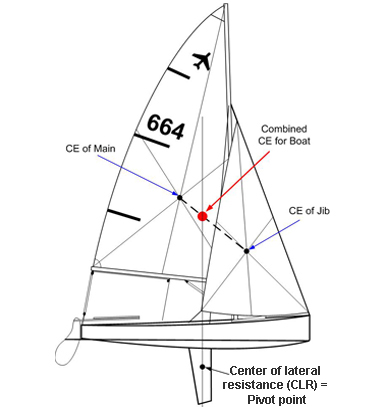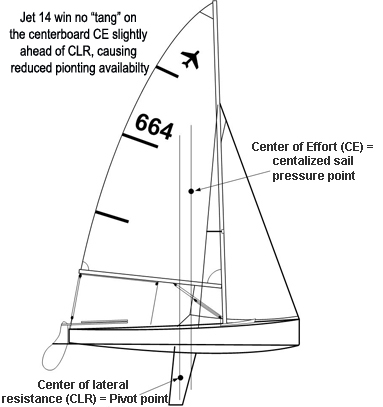Get Your Centerboard Vertical
The original Jet 14 centerboard design did not allow the board to go to a fully vertical position when lowered. This impacts boat balance between the Center of Lateral Resistance (CLR) or pivot point and the Center of Effort (CE) on the sails. This imbalance can cause reduced pointing ability and lee helm. See diagrams below

Centerboard is vertical- Total CE (combination of CE for Main and Jib) balanced directly over CLR

There are several different centerboard raising systems, depending on the Jet 14 deck support structure provided by the many builders over the years. Most of the boats today use around a 4:1 purchase system on aluminum boards and up to 6:1 for steel boards. The line runs to the top of the CB trunk and can be accessed by the crew or skipper. In order to get the CB to a fully vertical position, a tang must be welded onto the original steel or aluminum CB as shown below. This tang allows the CB to drop all the way into the CB trunk when in the down position. If it is welded parallel to the aft side of the board, it can also be used to show your centerboard angle.

Note: The upper surface of the CB trunk is also not a constant distance above the bottom of the hull for all boats, so there is no single “correct” tang size. You may need to experiment while the boat is on a hoist or in shallow water. If you tie a thin line through the CB hole and lower the board in shallow water, you can measure how much additional material is required. Make sure that the tang is long enough to extend out of the CB trunk when the board is down but not so long that it becomes a crew hazard when in the down position or interferes with the deck support structure when raised. If you have an aluminum board, it is safe to make it too long and then cut it off and round it over with a saw and a router. 5” was long enough on Hull 664 with the CB trunk at the legal minimum location. This tang extended the total board length 3”.